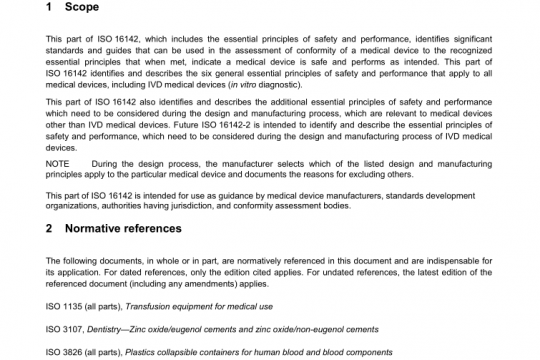AAMI TIR 60 pdf free download
AAMI TIR 60 pdf free download.Common mode rejection in ECG monitoring.
Common mode rejection testing Common mode rejection capability can be measured by the following procedure (Refer to the Annex for construction and application techniques for the CMR test fixture and line frequency source). a) With all patient electrode connections connected to a common node and with a parallel combination of a 51 kilohm resistor and a 47 nF capacitor, in series with each patient lead, including the RL lead, if supplied, apply a line frequency, 20 V rms signal to the common node through a 100 pF capacitor. The negative side of the generator is connected to power ground, and the device is operated at the full frequency bandwidth of the device and at a gain of 10 mm/mV or higher. Switches S1 through Sn are open; Sa is closed. With the patient cable disconnected, adjust C such that the voltage across it is 10 V rms; b) Verify that the measured p-v output noise over a 60 second time period does not exceed 1 mV RTI for each available lead setting; C) Repeat the test with a + 300 mV and – 300 mV dc offset in series with the imbalance impedance, by opening Sa and testing with the double-pole, double-throw (DPDT) switch in each of its two positions; d) Repeat steps (a) through (C) with each of the switches S1 through Sn, in turn, closed. History The discussion below differs very lttle from the rationale presented for common mode rejection since at least as early as EC13:1992. This history is not included in modern-day IEC ECG performance standards. Despite the age of the papers that are referenced below, and the fact that today’s standards mandate a common mode rejection of at least 28,000:1, much of this discussion – particularly details relating to CMR test fixture design – is still relevant today.In the earlier decades of ECG use, there appeared to be a wide variation in common mode rejection performance among ECG devices. Testing done at both Utah Biomedical Test Laboratory (Schoenberg et al., 1977) and the ECRI Institute (1973) showed that the American Heart Association (AHA)’s 1967 recommendation of 10,000:1 common mode rejection (Kossman et all, 1967) may be vastly surpassed (70,000:1) or not complied with (400:1). Seven of the nine devices tested by UBTL passed the common mode rejection test defined in the 1967 AHA recommendations. The isolated patient circuit and the driven right leg concept had introduced problems in defining and measuring common mode rejection. Basically, common mode rejection provides the ability to reject a signal that is applied to both sides of a differential amplifier. For high-impedance inputs to the amplifier, this generally requires very low currents and exactly matched impedances. With the high-input impedance requirements and the protective circuitry at the front end, such a goal was hard to attain in practice. The common mode rejection ratio for isolated patient circuits, measured relative to power or chassis ground, generally exceeded 10,000:1 in most recorders measured by UBTL. The circuit for common mode rejection testing described in this standard is based on IEC recommendations; a similar method is described in the 1975 AHA recommendations.AAMI TIR 60 pdf download.
Other IEC Standards
-

ANSI AAMI ISO 16142-1 pdf free download – non-IVD medical devices and guidance on the selection of standards
AAMI standards list DOWNLOAD -

ANSI AAMI ISO 16142-2 pdf free download – General essential principles and additional specifc essential principles
AAMI standards list DOWNLOAD


